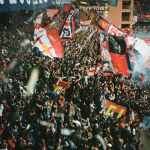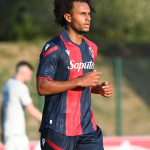
So how tho decide wich jersey to wear in a football match?
What Serie A and UEFA rules say
February 5th, 2021
In recent weeks there have been some quite embarrassing cases of jersey selection. Starting with Sivasspor-Basaksehir, with locals playing in the snow in a white suit, confusing themselves with the whitewashed field. Or, even more resounding - given the presence of the public at the stadium - the AC Milan-Inter Milan derby of 2016, in which the teams had both played with the first jerseys, in that season both with a lot of black, and neither from the stands nor on tv could you distinguish well who the Rossoneri were and who the Nerazzurri were. On his return, after twenty years, AC Milan returned to play a derby with the white shirt. But to decide which jersey to play with there is a clear procedure.
There is one for each championship, and it's not just about mating to do during races. In fact, there are also rules for undercuts, for the use of shorts and socks, for the presence of which (and how many) sponsors can go. Every year, this vedemecum of the aesthetics of the championship is updated according to the news accumulated over the years or, if any, due to accidents in previous seasons.
In that of Serie A it is specified: it is not mandatory to have more than two jerseys. Each team must have a first and a second uniform to alternate with the colors of the opposing team (theoretically, to be alternated between home and away games), but, if one club wants to have others, there are no constraints on the part of the Football League. The first two jerseys, however, it says, must be "noticeably at odds" in terms of colors - the reason why, among the suits of the teams, there is so much disparity - and before the start of the championship, each club has all the jerseys of the other teams of the tournament. An operation that serves to be able to decide, on the basis of the comparison, the race uniforms that will be applied to the players on the field. In fact, before a meeting, the arbitration panel analyzes the jerseys and checks that the official parameters - measures of logos, sponsors - and also the chromatic difference are respected. It is therefore up to the referee to accept the proposal of the two teams: the principle is the non-confondibility of colors with the opposing team. Each suit, can have a maximum of three colors, and among these, there must be one dominant on all three parts of the suit - shirt, shorts and socks - both forward and behind. A fourth color can be used for writing or small details. Moreover, in case there is a case of color confusion, the hosted team will have to change the suit.
In Serie A there are also limitations for the exposure - but not sponsorship - of brands related to betting companies - for the Dignity Decree approved in 2018.
For example, this year Rome uses yellow, red, orange and even a darker red, but it has the inscriptions of names and numbers in yellow. In this case it is allowed because the two shades of red are considered in the same way. Instead, in the 2015/16 season, Inter Milan had, in the 'Home' suit, white shorts and socks, shirt with black and blue (therefore three colors) and writings of names and numbers in fluorescent yellow. This is the classic case of the three basic colors plus one for details. In Serie A, this year, we have tended to see a bichromatic combination. Lazio (biancoceleste, white writing), Parma (black and white with white writing, yellow-blue with blue writing).
In addition, UEFA prohibits the display of sponsors of companies that produce super alcohol or tobacco. In practice, there are no problems for beer - Heineken is the main partner of the Champions League -, while for any brands of liquor or wine there are restrictions. No problem for betting sites. In any case, each team qualified for a European competition must comply with the rules on sponsors of the host team federation, and therefore, comply with that rule. At example, in Serie A teams cannot play using betting sponsor, and last year, in Champions League tie Atalanta-Valencia, Spanish side used a jersey with no sponsor - beacause they had Bwin.































